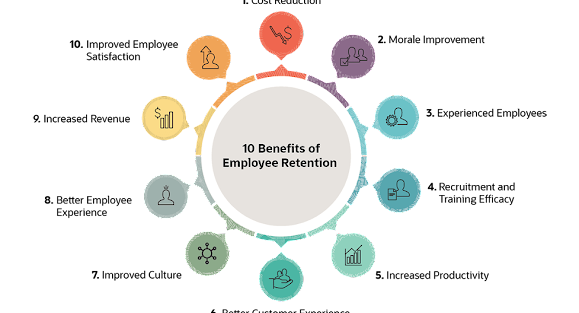نظرية الاندماج الوظيفي
العوامل المؤثرة للحفاظ على الموظفين
( JOB Embeddeness )
- ماذا نعني بالاندماج الوظيفي ؟
تعرف نظرية الاندماج الوظيفي على انها مجموعة القوى التي تؤثر على الموظف وتدفعه للبقاء في العمل سواء كانت هذه القوى مرتبطة ببيئة العمل أو المنطقة التي يسكن فيها . ويمكن تمييز نظرية الاندماج الوظيفي عن مفهوم التسرب الوظيفي في ان تركيز نظرية الاندماج الوظيفي ينصب على جميع العوامل التي تبقي الموظف في وظيفتة بدلا من العوامل النفسية التي تدفع الموظف على الاستقالة .
- ماهي أنواع الاندماج الوظيفي ؟
ينقسم الاندماج الوظيفي الى قسمين رئيسيين :
القسم الاول يشمل جميع الروابط والقوى التي تتشكل بين الموظف وبيئة العمل ( On-job Embeddeness)
القسم الثاني يشمل جميع الروابط والقوى التي تتشكل بين الموظف والمنطقة التي يسكن فيها (Off-job Embeddeness ).
القسم الاول / العوامل المرتبطة ببيئة العمل ( On-job embeddeness )
ينقسم هذا النوع الاول الى ثلاثة اقسام :
- العلاقات مع الزملاء والمشرفين داخل بيئة العمل ويرمز لها ب( LINKS )
- الملائمة والتوافق مع الاخرين داخل بيئة العمل والتي يرمز لها ب ( FIT )
- الخسارة المادية التي من الممكن ان تحدث للموظف في حال ترك الوظيفة والتي يرمز لها ب (Sacrifice )
ينقسم النوع الثاني ( Off-job Embeddeness ) الى ثلاثة اقسام :
- العلاقات مع الاخرين داخل المنطقة التي يعيش فيها الموظف ويرمز لها ب( LINKS )
- الملائمة والتوافق مع الاخرين داخل المنطقة التي يعيش فيها الموظف والتي يرمز لها ب ( FIT )
- الخسارة المادية التي من الممكن ان تحدث للموظف في حال ترك المنطقة التي يعيش فيها والتي يرمز لها ب (Sacrifice ).
أنواع الاندماج الوظيفي :

ماذا نعني بالروابط ( LINKS on -job ) داخل بيئة العمل .
هي الروابط التي تتشكل بين الموظف وزملاء العمل او المشرفين داخل العمل .
ماذا نعني بالروابط ( LINKS off-job ) داخل المنطقة التي يسكن فيها الموظف .
هي الروابط التي تتشكل من خلال علاقة الموظف بزصدقاء خارج بيذة العمل وذلك عن طريق تكوين شبكة اجتماعية او عائلية في المنطقة التي يسكن فيها الموظف . ايضا انضمام الموظف الى بعض المنظمات الخيرية او الاجتماعية او الدينية يساهم في ارتباط الموظف بالمنطقة التي يسكن فيها ، ايضا اشتراك الموظف في الاندية الرياضية داخل المنطقة قد يعزز من ارتباط الموظف في المنطقة التي يسكن فيها .
ماذا نعني بالملائمة والتوافق بين الموظف وبيئة العمل ( FIT- on job )
هي الروابط التي تتشكل بين الموظف وبيئة العمل نتيجة ملائمة القيم والاهداف المهنية للموظف مع بيئة وثقافة الشركة .
ماذا نعني بالملائمة والتوافق بين الموظف والمنطقة التي يسكن فيها الموظف ( FIT- off job )
هي الروابط التي تتشكل بين الموظف والمنطقة التي يسكن فيها الموظف وذلك من خلال ملائمة المناخ العام للموظف مثل الطقس او وساذل الراحة الموجودة في المنطقة او الانشطة الترفيهية الموجودة في المنطقة التي يسكن فيها الموظف ، ايضا مستوى الامان في المنطقة يساعد في نمو الروابط بين الموظف والمنطقة التي يسكن فيها .
ماذا نعني بالخسارة المتوقعة للموظف اذا تم ترك العمل (Sacrifice on-job )
هي المميزات المالية والمادية التي من الممكن ان يخسرها الموظف في حال ترك العمل .
ماذا نعني بالخسارة المتوقعة للموظف اذا ترك المنطقة التي يسكن فيه (Sacrifice off-job )
هي المميزات المالية او المادية التي من الممكن ان يخسرها الموظف في حال ان ترك المنطقة التي يسكن فيها مثل وجود مدارس للاطفال ذات جودة عالية واسعارها مناسبة ، ايجارات سكن منخفضة .
ماهي اهمية نظرية الاندماج الوظيفي لموظفي الموارد البشرية ؟
يمكن من خلال تطبيق نظرية الاندماج الوظيفي تصميم وتطوير ممارسات الموارد البشرية والتي تنمي الروابط بين الموظف وبيئة العمل او المنطقة التي يسكن فيها . يمكن لمختصي التوظيف اختيار المرشحين المناسبين وفق معرفة الروابط الموجوده بين الموظف والمنطقة التي يسكن فيها ، ايضا يمكن لمختصي الموارد البشرية تطوير سياسات التوازن الوظيفي بين بيئة العمل والحياة الخاصة للموظف .
ماهي اهمية الحفاظ على الموظفين ؟
من اهم الاسباب التي تدفع اصحاب العمل للحفاظ علي موظفيهم يمكن تحديدها كالتالي :
- خفض التكاليف المرتبطة بالتوظيف.
- رفع معنويات الموظفين
- تعزيز خبرات الموظفين
- رفع كفاءة التدريب
- رفع مستوى انتاجية الموظفين
- تحسين الصورة الذهنية لدى العملاء
- زيادة حجم العائد المادي .
- رفع مستوى الرضا الوظيفي لدى الموظفين .



